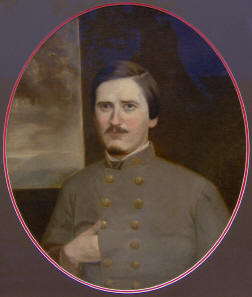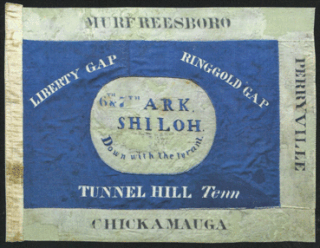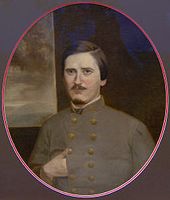
The Battle of Baton Rouge was a ground and naval battle in the American Civil War fought in East Baton Rouge Parish, Louisiana, on August 5, 1862. The Union victory halted Confederate attempts to recapture the capital city of Louisiana.

The Texas Brigade was an infantry formation of the Confederate Army that distinguished itself in the American Civil War. Along with the Stonewall Brigade, they were considered the Confederate Army's shock troops. It fought in every major battle of the Eastern Theater except Chancellorsville.

The 1st Kentucky Artillery was an artillery battery that was a member of the Orphan Brigade in the Confederate States Army during the American Civil War. It fought in several engagements throughout the Western Theater, including the battles of Shiloh, Baton Rouge, Siege of Jackson, Sulphur Trestle, Resaca, Murfreesboro, Jonesborough, Chickamauga, Missionary Ridge, and Johnsonville. Following the end of the Atlanta Campaign, Cobb's Battery was detached from the Orphan Brigade and reassigned to defend Mobile, Alabama.
Byrne's Battery was a light artillery battery in the Confederate Army during the American Civil War. It fought exclusively in the Western Theater and suffered among the highest casualties of Confederate batteries at the Battle of Stones River.

The Graves Battery, which had 73 troops and was led by Major Rice E. Graves Jr., was a part of the First Kentucky C Company, led by General John C. Breckinridge. This company was, in turn, a component of the First Kentucky Brigade, nicknamed the "Orphan Brigade".
The 2nd Kentucky Infantry Regiment was an infantry regiment that served in the Confederate States Army during the American Civil War. It was part of the First Kentucky Brigade.
The 39th Regiment Indiana Infantry was an infantry regiment that served in the Union Army during the American Civil War. The regiment fought at Shiloh, Corinth, and Stones River. In April 1863 the unit acquired horses and Spencer rifles and became mounted infantry, serving in the Tullahoma campaign and at Chickamauga. On October 15, 1863, the unit was renamed the 8th Indiana Cavalry Regiment.
The 3rd Kentucky Infantry Regiment was a volunteer infantry regiment that served in the Confederate States Army during the American Civil War. It was part of the First Kentucky Brigade through August 1862.

The 4th Kentucky Infantry Regiment was an infantry regiment that served in the Confederate States Army during the American Civil War. It was part of the First Kentucky Brigade.

The 5th Kentucky Infantry Regiment was an infantry regiment that served in the Confederate States Army during the American Civil War. In 1863 it became part of the First Kentucky Brigade.
The 6th Kentucky Infantry Regiment was an infantry regiment that served in the Confederate States Army during the American Civil War. It was formed from Nelson, Barren, and surrounding counties. It was also part of the First Kentucky Brigade.
The 7th Kentucky Infantry Regiment was an infantry regiment that served in the Confederate States Army during the American Civil War.
The 8th Kentucky Infantry Regiment was an infantry regiment that served in the Confederate States Army during the American Civil War.
The 9th Kentucky Infantry Regiment was an infantry regiment that served in the Confederate States Army during the American Civil War. It was part of the First Kentucky Brigade.

Rice Evan Graves, Jr. was an artillery officer in the Confederate States Army during the American Civil War. He was killed in the Battle of Chickamauga.

The 7th Arkansas Volunteer Infantry (1861−1865) was a Confederate Army infantry regiment during the American Civil War. Organized mainly from companies, including several prewar volunteer militia companies, raised in northeastern Arkansas, the regiment was among the first transferred to Confederate service, and spent virtually the entire war serving east of the Mississippi River. After the unit sustained heavy casualties in the Battle of Shiloh and the Kentucky Campaign, the unit spent most of the rest of the war field consolidated with the 6th Arkansas Infantry Regiment to form the 6th/7th Arkansas Infantry Regiment.

The 9th Arkansas Infantry Regiment was a regiment of the Confederate States Army during the American Civil War. It served in the Western Theater, seeing action in the Vicksburg, Tennessee and Georgia campaigns. Due to attrition; the 9th Arkansas was consolidated several times with other Arkansas regiments, finally merging in 1865 into the 1st Arkansas Consolidated Mounted Rifles.

Benjamin Hardin Helm was an American politician, attorney, and Confederate brigadier general. A son of Kentucky governor John L. Helm, he was born in Bardstown, Kentucky. He attended the Kentucky Military Institute and the West Point Military Academy and then studied law at the University of Louisville and Harvard University. He served as a state legislator and the state's attorney in Kentucky. Helm was offered the position of Union Army paymaster by his brother-in-law, President Abraham Lincoln, a position which he declined. Helm joined the Confederate States Army. As a brigadier general, Helm commanded the 1st Kentucky Brigade, more commonly known as The Orphan Brigade. He died on the battlefield during the Battle of Chickamauga.
Pillow Flying Artillery was a Tennessee battery of artillery in the Confederate Army in the early years of the American Civil War. It was mustered into service in Memphis and likely outfitted at Fort Pillow, Tennessee. Also known as Miller's Tennessee Battery, it was reported by Gen. Albert Sidney Johnston as arriving at Bowling Green, KY, from Columbus, KY with an aggregate of 70 men. Records of this battery exist from 1861. The battery is not mentioned in any records after May 1862.

The 20th Louisiana Infantry Regiment was a unit of volunteers recruited in Louisiana that fought in the Confederate States Army during the American Civil War. The unit began its existence as the 6th Louisiana Battalion in September 1861. The battalion was augmented to regimental strength in January 1862 at New Orleans and served during the war in the Western Theater of the American Civil War. The regiment fought at Shiloh, Farmington, and Perryville in 1862. After being reduced in numbers, the regiment was consolidated with the 13th Louisiana Infantry Regiment and served at Stones River, Jackson, Chickamauga, and Missionary Ridge in 1863. The 13th-20th Consolidated Louisiana fought at Resaca, New Hope Church, Ezra Church, and Nashville in 1864. The consolidation with the 13th Louisiana was discontinued in February 1865 and the regiment was re-consolidated with other units. It fought its final battle at Spanish Fort one month before surrendering in May 1865.












